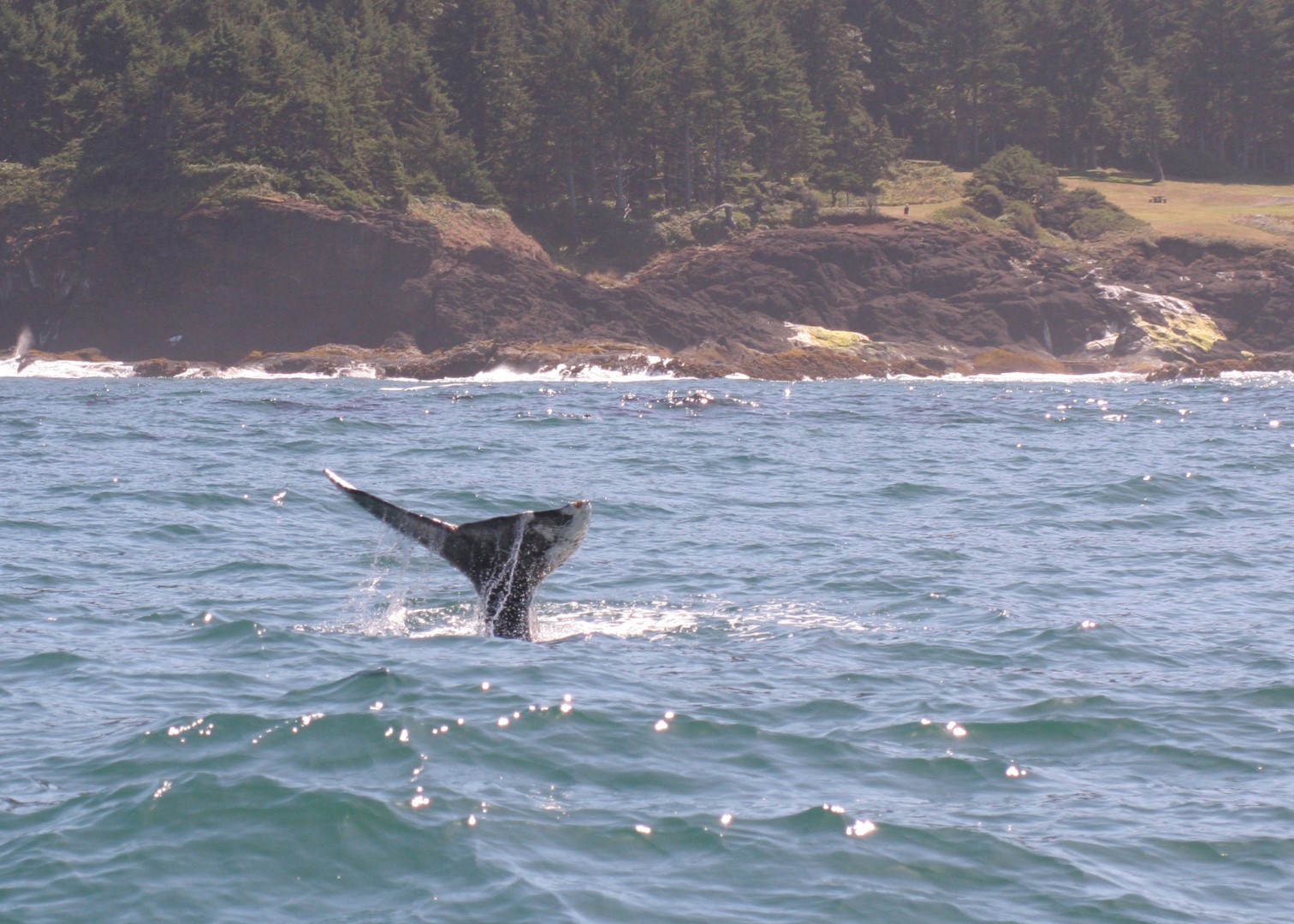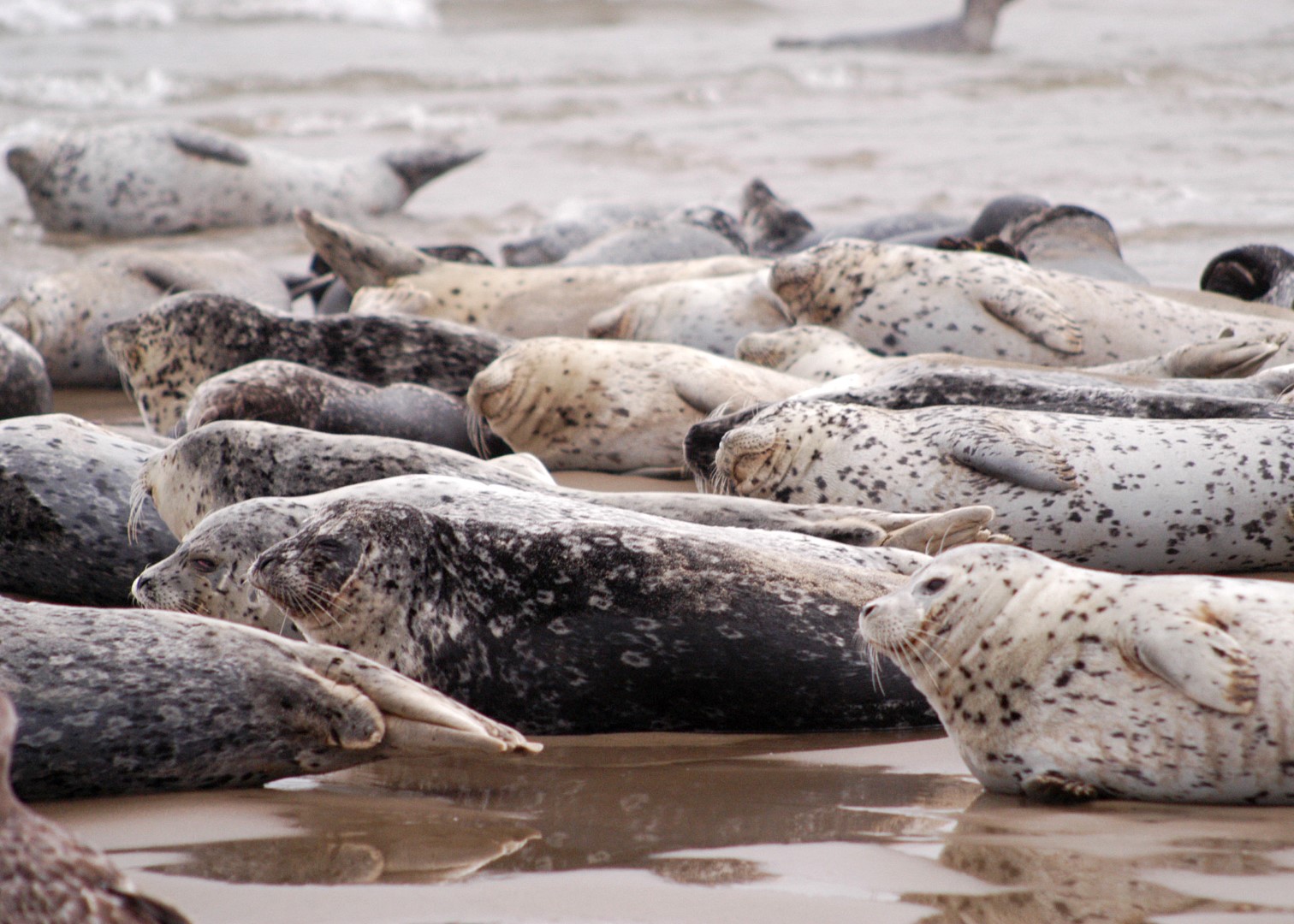A variety of marine mammals inhabit or visit the Otter Rock Marine Reserve. Here are a few of the most common marine mammals you may see while visiting.
While looking offshore at the Otter Rock Marine Reserve, you may see whale spouts between April and late September. Gray whales are the most common whale species seen in the area. They can grow to 50 feet in length and are gray in color as their name suggests. Gray whales eat by “filtering” food from ocean water and bottom sediment through baleen which look like long brushes in their mouths and are made of the same material as our fingernails. You may see the flukes (tails) of gray whales as they repeatedly dive to the shallow bottom of the Otter Rock Marine Reserve to feed.
We are lucky to glimpse some of the 20,000 gray whales that migrate in spring and winter along the Oregon Coast. From February to May, they travel north to their summer feeding grounds in the Bering Sea off the coast of Alaska. From September to December, they travel back south to their breeding grounds in the lagoons of Baja, Mexico. After having their young, they repeat their cycle of northern migration.
A resident population of about 200 gray whales do not complete the full northern migration and remain along the central Oregon Coast. From May through September, resident gray whales feed among the kelp forests in the marine reserve. Organisms such as mysid shrimp that live in the kelp forests at Otter Rock, near Cape Foulweather, and at Depoe Bay typically provide enough food to support this group of whales throughout the summer. This is the time when gray whales are most visible from the shore.

(Gray whale, Photo by Oregon Department of Fish and Wildlife)
Harbor seals forage in the marine reserve and often haul out on nearby rocks to rest between dives or to hide from predators such as orcas. Harbor seals are tan, gray, or silvery white with dark spots. Seal pups (baby seals) typically arrive from May to June and rely on their mother’s care until they are 4-6 weeks old. Although the pups can swim at birth, they often wait on the beach while their mothers forage at sea. Once they are weaned, seal pups will learn to forage in the shallow waters alone.

(Harbor seals, Photo by Oregon Department of Fish and Wildlife)
Harbor seals blend in easily with rocks, and sometimes you may not realize they are present until you get too close. Typically, seals will raise their heads to let you know that they are there. That indicates that you need to back away. Seal pups often wait on the beach while their mothers forage, so just because they are alone does not mean they’re abandoned. It is very important to keep your distance and avoid disturbing them. Harbor seals are federally protected under the Marine Mammal Protection Act. A minimum distance of 100 yards is required. Back up slowly if you are accidentally too close. Never try to touch a seal, and if you see a dead or injured seal, do not approach it. Like all marine animals, harbor seals can carry disease. You can report a dead or injured seal to the Oregon State Marine Mammal Stranding Network hotline at (541) 270-6830.
Sea lions are much larger and noisier than their harbor seal cousins. They can be distinguished by their brown fur, external ear flaps, and large front flippers that allow them to move comfortably on land.
California sea lions are rarely spotted around the Otter Rock Marine Reserve. Unlike seals, they do not use the nearshore at Otter Rock Marine Reserve as a location to haul out or rest.
Sea lions rarely come on shore at Otter Rock’s nearshore unless sick. They are susceptible to a disease called leptospirosis. This disease is easily spread to other mammals, including dogs. Sea lions are protected under the Marine Mammal Protection Act.
Keep your distance, and never let your dog approach these animals. Never try to touch a sea lion or get close for a selfie. Sea lions have a nasty bite that can spread disease easily to humans. If you see a dead or injured sea lion, do not approach it. You can report a dead or injured sea lion to the Oregon State Marine Mammal Stranding Network hotline at (541) 270-6830.
The best place to observe sea lions safely is at the docks built especially for them at the old bayfront in Newport, Oregon.
Despite its namesake, Otter Rock Marine Reserve is no longer home to sea otters. In fact, there are no more native sea otters along the Oregon Coast. Sea otters were hunted to extinction along the coast in the early 1900s as a result of the fur trade. This was a huge loss both culturally and ecologically. A future reintroduction effort could help ensure the resilience of Oregon’s nearshore ecosystems. The Elakha Alliance, a non-profit organization formed by tribal and conservation leaders, is working toward restoring a healthy population of sea otters to the Oregon coast.